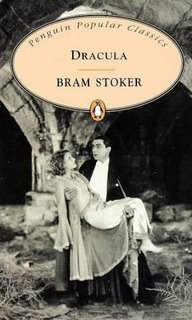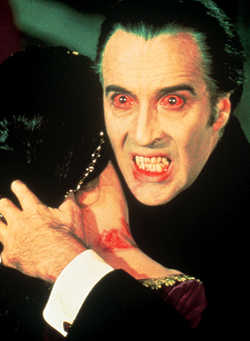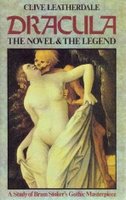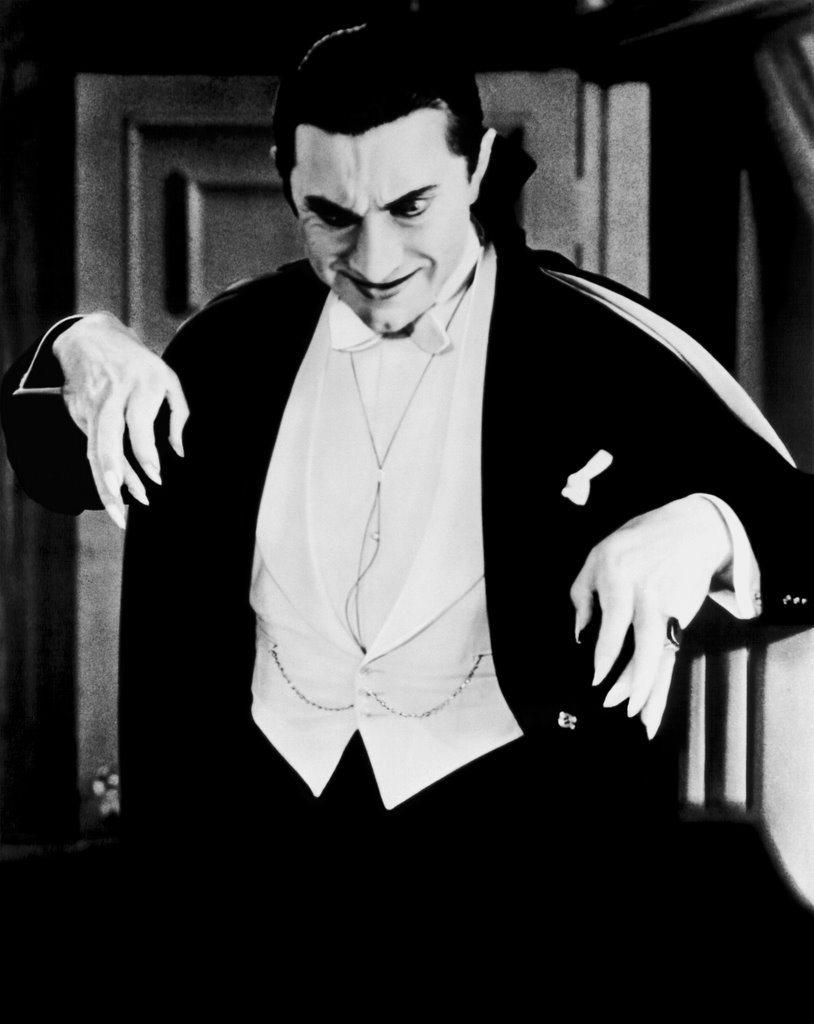 Regular readers of Taliesin Meets the Vampires will know that I have been mulling over, for some time, just how I might summarise and condense the plot and impact of Bram Stoker’s seminal work into a classic literature piece. Finally I’ve decided just to start typing and see what comes out!
Regular readers of Taliesin Meets the Vampires will know that I have been mulling over, for some time, just how I might summarise and condense the plot and impact of Bram Stoker’s seminal work into a classic literature piece. Finally I’ve decided just to start typing and see what comes out!
Dracula was first published on May 18th 1897 and, to my knowledge, has never been out of print since. The novel itself is an epistolary novel, by that I mean to say it is made up of a series of diary entries, newspaper cuttings and letters. This allows multiple voices within the novel and yet it maintains, primarily, a first person perspective.
A basic plot summary sees the novel begin with junior solicitor Jonathon Harker travelling to Transylvania to meet with his client, one Count Dracula, in order to provide legal assistance for a number of real estate purchases in London. Dracula is, of course, a vampire and Harker’s account of his time in Castle Dracula is a rich gothic horror narrative.
Eventually, Harker is left to the mercy of the Count’s vampire brides whilst he himself travels to England. The ship he travels on, the Demeter, runs aground at Whitby where Harker’s fiancé Mina Murray is visiting with her friend Lucy Westenra. Lucy has three suitors Jack Seward (a doctor who runs an asylum), Quincy Morris (a Texan) and Arthur Holmwood (son of Lord Godalming). It is Arthur whom she chooses to marry but the vampire has started visiting the girl, draining her of her blood. His attentions continue when she moves back to London.
 Seward has sought help from his old tutor and friend Abraham Van Helsing, who recognises her illness for what it really is. Unfortunately they are not, despite effort, able to save the girl. Children start to be stalked at night by the Bloofer Lady and Van Helsing realises that it is Lucy returned. He, with her suitors, have to destroy her.
Seward has sought help from his old tutor and friend Abraham Van Helsing, who recognises her illness for what it really is. Unfortunately they are not, despite effort, able to save the girl. Children start to be stalked at night by the Bloofer Lady and Van Helsing realises that it is Lucy returned. He, with her suitors, have to destroy her.
The companions set their sights on the source of their woes and, with the help of Harker and Mina, now married and returned from Transylvania – where Mina had travelled following his escape from the castle, track the Count down.
The Count visits Mina and, with the exchange of blood, ties her to himself before fleeing England but Van Helsing uses that connection to track him, allowing the companions to chase him back to Castle Dracula.
What I have given is the barest bones of the plot outline and I have missed one important character out completely. Renfield is a patient in Seward’s asylum who consumes the lives of flies, spiders and birds in order to extend his own life. He acts almost as a psychic barometer regarding the vampire.
The book can be read simply as an excellent piece of gothic horror fiction but many other interpretations have been given to the novel. It has been seen, for example, as a discourse on England and the influx of “barbarian foreigners” which threatened the English way of life. It has been seen as a discourse on the scientific (Stoker uses the height of science within his novel, Seward records his journal entries on a phonograph, Van Helsing performs blood transfusions) against the superstitious. There have been Freudian readings of the text and interpretations regarding the birth of feminism.
 Anyone interested in the various interpretations of Dracula could do worse than seek out the book “Dracula: The Novel and the Legend - A Study of Bram Stoker's Gothic Masterpiece” by Clive Leatherdale which is a fantastic study. Also by Leatherdale is the book “The Origins of Dracula” which is mainly a series of extracts from sources Stoker used as research when writing his book.
Anyone interested in the various interpretations of Dracula could do worse than seek out the book “Dracula: The Novel and the Legend - A Study of Bram Stoker's Gothic Masterpiece” by Clive Leatherdale which is a fantastic study. Also by Leatherdale is the book “The Origins of Dracula” which is mainly a series of extracts from sources Stoker used as research when writing his book.
It would be difficult, if not impossible, to list all the films that directly concern Dracula. The earliest, still available, film based on the novel was Nosferatu (1922) and the book has been interpreted into film, or the character used, time and time again. Dracula has become part of the world’s cultural identity.
The main thing to note, really, about Dracula as a movie vehicle is that there is not one single film, that I can think of, that has followed the story exactly. Character’s shift and change, romance is added where none existed and locations are lost or are added. That said there are many, many good adaptations and I will do no more than suggest you have a browse through the film review section to find some of those.
 One way in which the movies changed the book was by making the Count a dapper and, even, sexual being. The Lugosi look, if I can call it that, actually came from the stage and was introduced into the movies through the 1931 adaptation . Stoker’s Count was very different:
One way in which the movies changed the book was by making the Count a dapper and, even, sexual being. The Lugosi look, if I can call it that, actually came from the stage and was introduced into the movies through the 1931 adaptation . Stoker’s Count was very different:
“His face was a strong, a very strong, aquiline, with high bridge of the thin nose and peculiarly arched nostrils, with lofty domed forehead, and hair growing scantily round the temples but profusely elsewhere. His eyebrows were very massive, almost meeting over the nose, and with bushy hair that seemed to curl in its own profusion. The mouth, so far as I could see it under the heavy moustache, was fixed and rather cruel-looking, with peculiarly sharp white teeth. These protruded over the lips, whose remarkable ruddiness showed astonishing vitality in a man of his years. For the rest, his ears were pale, and at the tops extremely pointed. The chin was broad and strong, and the cheeks firm though thin. The general effect was one of extraordinary pallor.
“Hitherto I had noticed the backs of his hands as they lay on his knees in the firelight, and they had seemed rather white and fine. But seeing them now close to me, I could not but notice that they were rather coarse, broad, with squat fingers. Strange to say, there were hairs in the centre of the palm. The nails were long and fine, and cut to a sharp point. As the Count leaned over me and his hands touched me, I could not repress a shudder. It may have been that his breath was rank, but a horrible feeling of nausea came over me, which, do what I would, I could not conceal.”
In the book Stoker introduced us to many of the modern rules of vampirism, the effect of holy items, the transformation into and control of animals (specifically transformation into wolf and bat), the ability to pass through thin spaces etc. He also gave us the word un-dead, in fact that was to be the title of the novel originally. However, the effect of sunlight is an invention of cinema; Stoker’s Dracula could function in daylight though his powers were reduced.
I hope that I have given you a small flavour of the book, though I know I have done it scant justice, but I can really do no more than suggest that you read it for yourself. The book is public domain and many free e-book sites carry versions of it. You might also want to check out the excellent Dracula Blogged who post the book following the dates within the book and, for an audio version, check Librivox.
See also my review of the annotated novel notes, set in draft form - Drafts of Dracula
See also my review of the new Annotated Dracula.
See also my exploration into the Vlad Tepes connection (or lack thereof).
See also my exploration of the bat lore in Dracula and beyond (hosted at Vamped.org).
See also my review of Joel Emerson's expanded version of the novel, the Un-Dead.
See also my short look at Stoker's stage treatment of the novel.
See also the Deane & Balderstone plays
See also Ken Russell's unfilmed script.
See also Powers of Darkness - the translation of the Icelandic (1900) reimagining of the novel
See also Dracula in Istanbul - the translation of the Turkish (1929) reimagining of the novel















10 comments:
My favorite film version is still the BBC production starring Louis Jordan.
Hi Art, I agree that the BBC version is excellent (or should I say the first BBC version as they are making it again!)
That said the BBC radio play version was even better, if you ever get a chance to listen to it you should.)
Many thanks for the comment.
Dracula remains one of the books I still love the most, though the movie versions are not too great. Also, when one speaks of Dracula, the image that comes to my mind is that of a tall man with bright red eyes, French beard, dark gown, longish face and sharp canine teeth. None of the images that I see in reality ever seems to match the sheer elegance of Dracula's personality. Dracula was a count and remained a count even in all his ugliness. In other words, even teh apparent filth of his character was crowned by a majestic glory of his own aura.
Dracula book may have never been out of print, but the additional good news is that now one can access it freely since the book is now on the public domain and is hosted by some good classic literature websites such as http://www.webliterature.net/literature/Stoker/index.html
cheers anon...
I didn't put a link to a free e-version as there are so many. Personally, however, I think everyone should own a paper version.
The Bats and Broomsticks themed hotel in Whitby has copies of it by the bed rather than the bible.
Have you read "The Mysterious Stranger" it's a story written in 1863 who's Vampire has some striking direct parallels to Stoker's Novel. He has a mysterious affinity with Wolves, his Castle is in the Carpathian Mountains, and he starts out ugly and corpse like but become younger as he preys on his victim.
I certainly have (indeed I cover it on p112-114 of The Media Vampire).
What struck me most about the short was the fact that the female character is empowered to slay the vampire and procure her own cure - an exciting direction given when the story was written.
When talking about Vampires, we see Pre-Dracula and Post-Dracula allot. But most people don't know there was another Vampire book published the same year as Dracula.
http://www.amazon.com/gp/product/1906469164/ref=olp_product_details?ie=UTF8&colid=PWU83TPBRH2M&coliid=IY55YCVS04OWO&me=&seller=
Many, many thanks for that. I wasn't aware of it myself but rest assured it has been ordered ;)
I have nothing against any actor who performs Dracula but i always put Christopher lee first, why you may ask, the reason is that he is more menacing and his movemens are more sinister. and Christopher takes the role more seriously.
I have to say my first choice vacillates between Lee and Lugosi, though often rests with Lee
Post a Comment